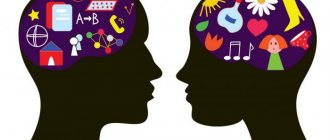- July 9, 2019
- Psychological terms
- Angelica Braldi
The concept of the zone of proximal development was formed in the thirties of the last century. This theory characterizes the connection between mental formation, the development of a child’s personality and his learning. Its author is the Soviet psychologist Lev Semenovich Vygotsky.
For many decades, the concept he developed was considered an axiom in the scientific and pedagogical community. Since 2000, Vygotsky's views on the cognitive development of children have not only been rethought, but also subjected to very aggressive criticism. This trend was called the “revisionist revolution.”
However, scientists who criticize the concept that Lev Semenovich Vygotsky formulated at the beginning of the last century do not offer their own alternative to this theory. Therefore, it cannot be considered outdated or no longer relevant at the moment.
Brief biography of Vygotsky
Lev Semenovich was born in 1896 in the town of Orsha, located in the Mogilev province. The future scientist grew up in Gomel, where the family moved shortly after his birth. He became the second child in a very large family. In total, his parents had eight children.
Initially, the scientist’s surname was “Vigotsky”. He changed it in 1923. Perhaps Lev Semenovich was ashamed of his Jewish origin, but it is likely that the reason was difficulties in pronunciation. There is also a widespread version that the change of name was due to the scientist’s desire to differ from his own uncle, a famous literary critic at that time.
His father was a merchant. Simkha Leibovich Vigotsky studied commerce at the Kharkov Commercial School. He successfully combined his trading activities with work as deputy manager of a branch of the United Bank. The future scientist’s mother worked as a teacher. Her name was Cecilia Moiseevna.
Vygotsky's parents were not poor people, and their children did not need anything. The children's primary education was provided by private teachers who came to their homes. Lev Semenovich entered the gymnasium immediately into the sixth grade, passing exams for the first five, which he did not attend.
In 1913, Vygotsky became a student at the Faculty of Medicine at Moscow University. However, he became interested in law and soon transferred to another faculty. As a student, he wrote many articles on literary and historical topics. Various magazines readily published them. In 1917, Lev Semenovich left Moscow University. He completed his education at Shanyavsky University at the Faculty of History and Philosophy.
In 1919, the future scientist was diagnosed with tuberculosis. He left Moscow, returning to his family in Gomel. Until 1922, he worked as a literature teacher at a labor school. He worked part-time at technical schools and at various evening courses, and actively participated in the training and retraining of teachers and workers in children's institutions.
The year 1922 became a turning point in the life of the future scientist. He got a job teaching at the Gomel Pedagogical College. A year later, Lev Semenovich began organizing a psychological laboratory at the same educational institution. In the summer of 1923, he led a group of students from the Moscow Institute who carried out a series of experiments in a laboratory office at a technical school in Gomel.
Lev Semenovich presented the results of these “experiments of youth” in the form of a scientific report at a congress on psychoneurology in Petrograd. At the same time, he met Alexander Romanovich Luria, who contributed to Vygotsky’s transfer to the Institute of Experimental Psychology, located in Moscow.
The scientist died in June 1934. His body was cremated, and the urn with his ashes was buried at the Novodevichy cemetery.
How the scientist himself determined the ZBR
The ZPD, or zone of proximal development, is defined by Vygotsky as a constructive theory. With its help, it is possible to characterize the relationship between the psychological characteristics of child development and learning processes.
The scientist himself described this concept very poetically, but very vaguely. In the scientific work “Dynamics of mental development of a schoolchild in connection with learning,” the zone of proximal development is defined by Vygotsky as follows: “Functions that have not yet matured, but are in this process. Those who are in their infancy will mature tomorrow. They are not fruits, but buds and flowers of development, that is, that which is capable of ripening.”
Lev Semenovich is characterized by abstract digressions and detached examples when explaining his own thoughts, which he sets out in scientific works. This scientist avoided language devoid of epithets. He believed that such a presentation simplifies understanding. This is how the zone of proximal development is defined by Vygotsky.
This manner contributed to the emergence of a mass of discrepancies and misunderstandings, which in our time has led to criticism and even denial of the work of this scientist.
Consultation “Child’s Zone of Proximal Development”
Alena Rybalko
Consultation “Child’s Zone of Proximal Development”
Child's zone of proximal development.
Zone of Proximal Development (ZPD)
- the level
of development achieved by a child in the process of his interaction with an adult, in the course of joint activities with him, but not manifested within the framework of individual activities. The concept of “
zone of proximal development ” was first discovered by L. S. Vygotsky in the early 1930s.
To determine the zone of proximal development, you need to know the zone of actual development .
The zone of actual development is the child’s that have already been formed, matured, and the child performs tasks associated with these abilities and skills without the help of adults. Children grow very quickly: what required help today will be done independently tomorrow . In the zone of proximal development, tasks are solved that the child is not yet confident in performing independently and needs help. The tasks that children do today with the help of an adult will be done by themselves tomorrow, and this will already become an actual development . In other words, when a skill moves into the zone of actual development , it opens up new opportunities for the child, since mastered actions are the support for further development . Conversely, every action for which a child has to strain mentally or physically spurs his development . And this is very important to understand! of development occurs .
As L. S. Vygotsky writes, “ the zone of proximal development determines functions that have not yet matured, but are in the process of maturation; functions that can be called not the fruits of development , but the buds of development , the flowers of development .
The level of actual development characterizes the successes of development , the results of development as of yesterday , and the zone of proximal development characterizes mental development for tomorrow .
Zone of proximal development , a logical consequence of the law of formation of higher mental functions, which are formed first in joint activity, in cooperation with other people and gradually become internal mental processes of the subject. When a mental process is formed in joint activity, it is in the zone of proximal development ; after formation, it becomes a form of actual development of the subject . The phenomenon of the zone of proximal development indicates the leading role of learning in the mental development of children . “Teaching is only good,” wrote L. S. Vygotsky, “when it goes ahead of development .” Then it awakens and brings to life many other functions that lie in the zone of proximal development . “Pedagogy should focus not on yesterday, but on tomorrow’s child development ,” wrote L. S. Vygotsky.
This distinguishes teaching a child, whose goal is his all-round development , from teaching specialized, technical skills, such as writing on a typewriter or riding a bicycle, which do not show any significant impact on development .
Therefore, learning is most fruitful only when it occurs within the period determined by the zone of proximal development . This period is called by many modern teachers, like Fortuin, Montessori, etc., a sensitive period.
According to L. S. Vygotsky, in cooperation a child is able to do much more than on his own. Cooperation is one of the parameters of the social environment, which is a source of development in ontogenesis . Cooperation can also take the form of imitation, but imitation is possible only because it lies in
the child’s “zone of proximal development . ” Imitation makes possible the “cultural
development of a child ” , the formation of higher mental functions in him.
Introduction of “ zone of proximal development ”
allowed pedagogy to develop a strategic direction in the process of organizing training:
it develops only that training that is focused on the “zone
of proximal development ” of a given
child . to teach a child only what he is already capable of learning, based on the achieved level of development .
One of them is related to the inclusion of the concept of ZPD in the diagnosis of mental development . The main methodological principle on which diagnostics, including ZPD, should be based is the specially organized cooperation of the child with an adult and a peer. Traditionally, the way to determine ZPD is to use dosed assistance when the child solves a test problem . An adult helps a child when difficulties arise. "Quantity"
and quality of care – an indicator of health and safety.
The child who solves a problem with minimal help from an adult has the greatest ZPD (Ivanova, 1976)
.
According to the author of the analysis, the method of dosed assistance is associated with a deeper diagnosis of current development , the study of mechanisms that ensure the solution of intellectual problems. This method shows that the current level of development is also not homogeneous , it has a certain internal structure.
Adult help acts as a tool for studying this individual, or age, structure. Helping an adult to a child can be divided into several stages:
first "dose"
- suggest how to do it;
the second is to show a clear example in the same picture (simulator, how to do it, or show an intermediate version of the implementation;
third - show the child , in the case of a letter - move the child's , i.e. show the method of action.
At the same time, the concept of the zone of proximal development has been criticized by a number of scientists (E. Erickson et al., who note that one of the dangers directly related to the zone of proximal development in the interpretation of L. S. Vygotsky is that “... that You should not try to push a child forward before he has developed abilities corresponding to the stage of development that he is currently in. This is especially important from the point of view of the epigenetic principle formulated by E. Erikson. As shown in the works of E. Erikson himself and his followers, ignoring the current needs of development leads to serious personal deformations and, moreover, mental disorders. As this practice demonstrates, extremely “fashionable”
Today, attempts by parents
“
develop ” their preschool children by teaching them counting and writing, foreign languages, music, etc. often not only cause damage to physical and mental health, but also rarely reduce the
child’s to learn when he reaches preschool age.
Nevertheless, the idea of a zone of proximal development in itself is undoubtedly fruitful, as evidenced by the interest shown in it not only in our country, but also abroad. The main idea of this theory is aimed at the most adequate assessment of the child's development prospects and his abilities .
In the article “The Problem of Age”
he expanded this concept and used it to characterize individual differences in children, showed the connection between the zone of
proximal development and sensitive periods of development , emphasizing that learning is more effective if carried out during the period of maturation of mental functions.
I propose to consider this concept using the example of a 10-month-old baby. So, our baby can crawl remarkably well and we can say that he has achieved perfection in this skill. This means that crawling is an area of active development - the skill has already been achieved and does not pose any difficulty for the baby. Crawling itself does practically nothing for a child’s development , but at the same time it is the most important support tool for the further development of many other skills. The child crawls up to his mother and stands on his feet. He wants to go, but so far he can’t. And the mother, slightly supporting the baby, helps him walk. Walking, in this case, is a skill that the child is just mastering . It is located in its zone of proximal development . That is, the skill will appear soon, but for now walking is only available with help. Next, the baby crawled to his toys and took, say, a small pyramid. He shook off the rings himself, but he still can’t put them on in the correct order on his own. The mother hands the baby the necessary rings and the pyramid is assembled. Assembling a pyramid is also a zone of proximal development ; soon this action will become available without help. But shaking off the rings is already a fully mastered action and is a support for further development . Every action for which a child has to strain mentally or physically stimulates his development . However, it must be remembered that the benefit of such development will only be when new skills build on those already achieved. A sharp acceleration of development is inappropriate , since too often it leads not to the development of mental functions , but to inferiority complexes, to childhood “burnout”
.
of proximal development is especially relevant for those preschool children whose parents are seriously interested in early development . Orientation in the child's zone of proximal development allows parents to simultaneously be half a step ahead of their baby and half a step behind.
Behind - in order to follow the interests of the child , without imposing on him his own ideas about what should be interesting to him. And ahead - to flexibly adapt to the child’s , in order to create the proper motivation (without it there will be banal coaching, as well as the environment necessary for the development of the skill ).
Growing up, the baby simultaneously masters a huge number of different skills - riding a bicycle, drawing, counting, speaking, and so on. And each of these skills has its own zone of proximal development . For some skills it is very extensive - the child immediately catches a movement or some knowledge. And after it, more and more new skills are formed.
Usually, in this case they talk about the presence of abilities. But almost every child has skills that are very difficult for him and sometimes require significant help from an adult to master them. In this case, the zone will not be too large and additional efforts are required to expand it as much as possible. Fortunately, the zone of proximal development is mobile - in the process of classes it constantly expands, new experience is acquired, and on the basis of it the child improves more and more. The main thing is to notice that this is where the baby has problems and help him overcome them.
Constantly being inside a child’s zone of proximal development has another very important property. Determining the zone is impossible without close communication and cooperation with your child . And communication with adults and peers, including indirectly through play, is a powerful developmental stimulus . And here I would like to remind you that any early development are needed only for approximate direction. As a result of live communication with your child, you will find that you have created your own methodology - the one that your specific child needs based on his interests. You just need to look closely at it - every child always has something to build on. This will be precisely the area where the baby’s zone of proximal development is most extensive . Continuing to gradually expand it, adding new knowledge sometimes literally bit by bit, encouraging the child to come to his own conclusions, one day you will realize that your work was not in vain. But please never forget that the main thing is your friendship with your child and your mutual respect. Only in this case will you be able to help your child grow up to be a harmonious and happy person.
The development and learning of a child must follow his internal need and ability to perceive at the moment. The child needs to be offered something that he, firstly, can easily assimilate in a given period, that will be natural for him to assimilate, and secondly, give him what he needs at the moment, which provides a solid basis for further development .
Thus, from the point of view of L. S. Vygotsky, only an idea of the child’s current level of development , but not of his ability to assimilate new material. In order to assess development , it is necessary to assess the “gap”
between the results of a child’s independent activity
and what he can achieve with the help of adults.
L. S. Vygotsky illustrated this idea with the results of an experiment in which two boys were asked to complete a standard intelligence test for 8-year-old children (which corresponded to their real age)
.
After each of them successfully completed the task, they were asked, with the help of the experimenter, to solve more complex problems. At this stage, one of the subjects showed a result corresponding to the level of development of a 9-year-old child , while the other showed a result corresponding to a 12-year-old child. According to L. S. Vygotsky, this is evidence of different potential for learning in these two children, and the thus identified “distance between the level of actual (actual) development , determined by the results of independent completion of tasks, and the level of potential development , determined by the results of completing tasks under the guidance of an adult or in collaboration with more capable peers”2 and is the zone of proximal development .
As empirical confirmation of the theory of the zone , L. S. Vygotsky also cited the results of some foreign studies. For example, in the work “Mental development of children in the learning process”
he writes: “The American researcher McCarthy showed in relation to preschool age that if
a child from 3 to 5 years old is subjected to research, then he will have a group of functions that the child already has , but there is also another group of functions that the child does not independently possess , but owns it under leadership, in a team, in collaboration. It turns out that this second group of functions at the age of 5 to 7 years is mainly at the level of actual development . This study shows that what a child of 3-5 years old can do only under guidance, in cooperation and collectively, the same child from 5 to 7 years old can do independently.”
About the concept of ZBR
The concept of “Zone of Proximal Development” was first proposed in 1932, and this concept was finally formulated only at the beginning of 1934, that is, shortly before the death of Lev Semenovich.
The concept of ZPD includes processes for solving those problems that children cannot cope with on their own, without training and help from adults. The results achieved become the personal intellectual property of children, their skills, abilities, experience and knowledge.
The zone of proximal development is defined by Vygotsky as the direct influence an adult exerts on the processes of a child’s personal development. In other words, we can say that the psychological development of children directly depends on what and how adults teach them.
The practical usefulness of the concept of ZPD is that with the help of this concept it is possible not only to characterize the existing relationships between training and development, but also their prospects, potential opportunities and disadvantages. The concept of the zone of proximal development allows us to obtain a complete picture of the dynamics of the mental and emotional activity of children. This is extremely important for both teachers and parents.
Elements that make up a development plan
The structure of an individual development plan depends on the needs of the company and the employee. Typically the plan includes the following elements:
- Information about the employee. This is the name, position, department in which the employee works, planning period.
- Tasks. You must indicate your current professional activity.
- Recommendations. It is necessary to list recommendations for the development of professional competencies.
- Goals. It is necessary to list the goals for the implementation of certain activities, as well as indicate the time frame for achieving these goals.
- Results of the plan. The results are recorded. Comments may be included in this section.
If necessary, additional elements may be included in the plan.
How do development and learning relate?
As L. S. Vygotsky believed, the zone of proximal development is determined by the relationship between two main elements. How exactly are the processes of learning and development interconnected? Lev Semenovich believed that ZPD is a collective activity, close cooperation between adults and children. Of course, adults play a leading role in this tandem.
The source of children's personal development is their communication with other people. Society is necessary for the development that occurs during the learning process. According to Vygotsky, the zone of proximal development gives paramount importance to learning. This process must advance development, guide it and not allow stops, delays, or imbalances in it. Learning is primary and development is secondary.
Recommendations for drawing up IPR
When developing an individual development plan, it makes sense to be guided by the following recommendations:
- No more than two development directions are established per year. Only in this case can the correct efficiency be obtained.
- Each direction should include a full range of activities: theory, training under the guidance of experienced specialists, practice.
- Ensure an even load throughout the year.
- One and the same method of development cannot be grouped into one period. The right combination. For example, you should not assign an employee to read books for the entire month. Theory must be combined with practice.
- Leaders must evaluate the resources to carry out the plan. These are material costs and time.
Important!
To make the plan even more effective, it makes sense to involve several specialists in its creation: employees, HR representatives, consultants, trainers.
Before starting a new project, consider the following points:
- You need to select the category of personnel to be included in the program and the purpose of development (trainees, specialists, first-level managers, middle managers, top managers). Before making a choice, analyze the organization’s personnel problems, staff turnover, the main “holes” through which investments in personnel selection, adaptation, staff training, etc. flow.
- It is necessary to propose ways to identify areas of development in the selected category of employees.
- It is necessary to calculate the program budget and give forecasts for the return on investment of the project.
- Identify specific people who will be involved in the project.
- Indicate as precise a time frame as possible for completing the action.
- Indicate people who may be helpful in implementing the event (mentor, internal career consultant). Everyone is responsible for their function.
- Open the IPR for editing by employees, mentors, and staff. IPR is a business tool to which it is necessary to make operational changes.
- Create a core resource: a development fund bank. Start small: fill it with reference tips and literature, and then fill it out as the project develops and your experience grows. You will then split the bank into 2 parts: a mentor guide and an employee portal.
- Connect employees to the corporate library or create a book marathon practice where the group will share their impressions of the books they have read.
What is the difference between ZBR and ZAR
ZAR is a zone of current development. This concept is both the opposite of the ZPD and complements it. The zone of actual development is understood as the range of tasks that are available for independent solution. These are all things that children can cope with without the help of adults and without training, using existing knowledge, skills and abilities. This is the difference between the two concepts.
Both zones are interconnected and complement each other. ZAR is actually a direct consequence of ZPD. Thus, in order to cope with anything on their own, children first need to learn how to do it. Throughout the entire process of a child growing up, the ZAP follows the ZPD.
Zone of actual development – ability to work independently
According to the theory of L. S. Vygotsky, the development of a child must be considered from two sides. The kid already knows and can do something. Based on these skills, you can entrust him with work that the child has never done, and he can handle it on his own.
The zone of actual development is the sum of the knowledge and skills that we currently have. The concept was first proposed by the researcher himself, and it is used to this day. Characteristic features of this zone:
- the child has firmly mastered the material;
- he can independently perform tasks that do not go beyond the limits of current development;
- The student finds solutions to unfamiliar problems himself without the help of a teacher.
The child knows basic geometric shapes and colors. It will easily show a red ball or a green cone. Mom can give him the task of putting all the blue cubes in one box and the yellow ones in another, and the baby will cope with the work without guidance. If he only knows the names of the colors, but has no idea about the shape, blue rings, bars, and balls will fly into the box. Until knowledge of geometric shapes is included in the zone of actual development, the child will not be able to complete the task without the help of an adult.
A more complex condition can be introduced into problems. Mom asks to put black and brown objects in the basket and collect cubes and balls in one corner. At the initial stages, these lessons will help consolidate the acquired knowledge, but there will be no progress. After some time, the child himself will get bored with monotonous tasks and will want to learn something new. In order for development to continue, you need to move to the next stage, and here again you cannot do without the help of a mentor.
How the ZPD principle is used in pedagogy
The formation of the zone of proximal development, which is necessary for children, begins at the border of the ZAR. What does this mean? Only that a teacher or parent should not impose teaching or assistance on a child if there is no need for it.
ZPD is effective only when a difficult or new task arises for the child, the solution of which requires additional knowledge, skills, abilities or the help of an adult.
This is the principle of applying Vygotsky’s concept in pedagogy. Teachers or parents do not impose, interfere or solve problems for children, but help and guide them.
Help and training from adults must be effective for children's development. According to the ZPD concept, the effectiveness of teaching activities is assessed very simply. If children, after collaborating with adults, become able to independently cope with the task, then pedagogical activity is useful.
Stages of the development plan
Let's consider the main stages of developing an individual development plan:
- Formation. Recommendations for development are developed and then reviewed by the employee. The employee sets priorities for development. If necessary, a planning consultation is ordered.
- Planning. Drawing up a table indicating priorities and areas of development.
- Approval of the plan. The formed plan must be agreed upon with the boss. Changes are made if necessary.
- Plan approval. The manager is also involved in approving the plan.
- The developed development plan is analyzed for compliance with the following criteria:
- Having a logical, reasonable sequence. It is assumed that the employee solves simple problems first, and only then complex ones.
- Compliance with the main purpose. The plan outlines the skills that the employee must develop. The assigned tasks should contribute to the formation of this skill.
- Set deadlines. Development work must be completed on time. This will simplify monitoring their implementation.
- It is important that the plan is realistic. That is, the employee must have time to complete all development activities. For this reason, it is necessary to take into account its standard workload.
What is taken into account in the development process
The zone of proximal development according to Vygotsky takes into account sensitive periods. These are special stages in a child’s life, during which he is most predisposed to learning, developing a certain type of behavior, and is psychologically susceptible. According to Lev Semenovich, it is advisable to conduct training at those moments when the child is ready both psychologically and physiologically to acquire new skills, knowledge, and abilities.
Vygotsky especially emphasized the importance of sensitive stages and assigned them a key role in the success and efficiency of the learning and development processes of children. The scientist believed that these stages have a decisive influence on the entire process of personality formation. It is what children learn during such periods that affects their psychology and mental activity, determines their character, type of behavior, social adequacy, habits and much more.
Goals of the employee’s personal development plan
An individual development plan is drawn up with the following goals:
- Increasing staff loyalty.
- Professional Development.
- Increasing the competitiveness of products manufactured by the company.
- Increased operational efficiency.
- Planned development of a specialist.
- Coordination of work tasks.
- Improving control efficiency.
- Turning hypothetical goals into actions.
- Simplifying the analysis of a specialist’s strengths and weaknesses.
- Timely preparation for enterprise modernization.
- Ensuring human self-organization.
- Prioritization.
- Loyalty and development of the strongest employees.
- Motivating weaker employees to achieve better results and be included in the talent pool.
- Savings on attracting and developing new specialists.
- Prevent unexpected layoffs of key employees through greater control over their motivation.
Without a plan, an employee can also develop, but it will be chaotic. In addition, the employer will not be able to track the results and progress of work.
What promotes learning
The zone of proximal development in psychology is considered as a concept for organizing effective education for children, which ensures their comprehensive and complete development. What contributes to this?
As Lev Semenovich wrote, the key to the effectiveness of pedagogical activity (both on the part of teachers and parents) is the complex tasks offered to children. We are talking about tasks that a child cannot cope with on his own, since their solution requires new knowledge and skills.
The formation of a ZPD occurs through constant stimulation of development and the creation of conditions under which children have a need for learning. This is what contributes to its effectiveness. Children should need training, feel the need for new knowledge, and not just attend any classes and mechanically fulfill the demands of adults.
What from the theory of L.S. Is Vygotsky useful when teaching children?
In each lesson you need to use both zones of development. If your child goes to kindergarten, take an interest in their program, find out what the children studied today and in previous days. You can build your classes based on these skills. At the beginning of the lesson, it is better to repeat a little of the material already learned.
You want to teach your child to group concepts according to the “living-nonliving” principle. Yesterday the teacher told them about the seas. First, talk - the child will tell you what he learned, and then ask where to take the fish, water, jellyfish, stones. Ask your child to draw or sculpt a sea picture; during physical education classes, offer him exercises that imitate swimming or the movements of aquatic inhabitants. In this way, the child will receive not scattered information, but a unified picture of the world around him.
You need to prepare for classes with children in advance and have a little more planned material in stock for each lesson. Do not push your child if he cannot cope with some task. Sometimes learning occurs in leaps and bounds: first there is a long misunderstanding, then a sudden breakthrough - learning must proceed in an appropriate rhythm. For this case, you need spare material. For several lessons, the mother could not explain to her son how to form a square from 2 triangles, and suddenly he succeeded. The kid is delighted, he wants to do something else, but there are no figures or ideas at hand. But it was necessary to take out 2 semicircles and show how the moon is made from crescents, and then move on to dividing one figure into several others.
According to the theory of L.S. Vygotsky, the teacher must put the necessary information into the student’s head, tell all the new material or show the solution to the problem. You don't have to do everything yourself. Work together with your child, reason, push his thoughts onto the right path. If your student comes to the final conclusion himself, his joy will know no bounds. Parents' praise is very important for preschool children - do not forget to show how happy you are with your son or daughter's success.
According to the observations of teachers, the zone of proximal development, which characterizes the student’s potential, should be taken into account when teaching him. Mental activity should be constantly trained. If you do not encourage a child to learn new skills, he will not move forward and will stop at the level of current development. But you cannot give tasks above the student’s potential level: overwork can lead to nervous diseases and mental disorders. Prematurely “cramming” incomprehensible information into the head will discourage interest in learning, and the child will lose the incentive to acquire new knowledge and skills.
How the learning process is structured
Vygotsky believed that a teacher should be able to balance between ZPD and ZAP, alternating simple tasks with more complex ones, the solution of which requires little help, as well as with very complex ones that require new knowledge.
The teacher determines the following ZPD criteria:
- zone boundaries;
- problematic epicenter.
When presented with a ready-made solution, children do not learn anything, do not acquire new knowledge and do not realize the mistakes they have made. They do not accumulate experience and do not develop the ability to overcome difficulties.
How the relationship between teacher and child is built
In Vygotsky's framework, teachers and children are partners. Their relationship is considered equal. The constructive theory of ZPD denies the dominance of teachers over children.
Teachers and children (from Vygotsky’s point of view) are equal participants in the development process, subjects of educational activity who are unable to exist separately. Of course, this does not mean that familiarity is possible between teachers and students. ZPD implies an approach to organizing the development process in which the child begins to strive for self-learning.
Benefits and risks of IPR
Advantages of working on the development of IPR for an employee:
- you will get a clear plan for personal development within the organization (i.e. the shortest career path in this company will be indicated);
- the opportunity for this employee to advance faster than his colleagues;
- providing the employee with access to expensive and exclusive training programs (mentoring of top managers, business lunches with the director, trainings, master classes, access to an electronic library, coaching of an internal career consultant, participation in cross-functional projects, development of brand personnel within the company, developing networking between colleagues);
- strengthening skills to further promote oneself in the external labor market.
Risks associated with the implementation of IPR:
- the impossibility of calculating the exact amount of investment in IPR and the final benefit from the implementation of the personnel development program;
- incorrectly calculated direct program costs;
- employee leaving before the company receives the expected benefit from his development;
- “Star sickness” among employees.
Is language competence important?
Children's acquisition of social skills, new knowledge and their mental development are unlikely to be possible without language competence. This means the development of children’s speech, an increase in vocabulary, a change and complication of the language structure. Vygotsky believed that timely speech development directly affects the child’s psyche and encourages the child to learn.
Linguistic competence is a psychological system that is a combination of speech experience gained through communication and knowledge acquired in the learning process.
The main components of this system are:
- indicative - contains an analysis of the features of speech material that children intuitively rely on;
- operational – includes the totality and sequence of language skills used by children;
- emotional-volitional – takes into account various aspects of speech experience.
Vygotsky believed that speech development is extremely important. Without this process, the ZBR, like the ZAR, cannot be formed. Accordingly, the processes of development and learning do not begin.









